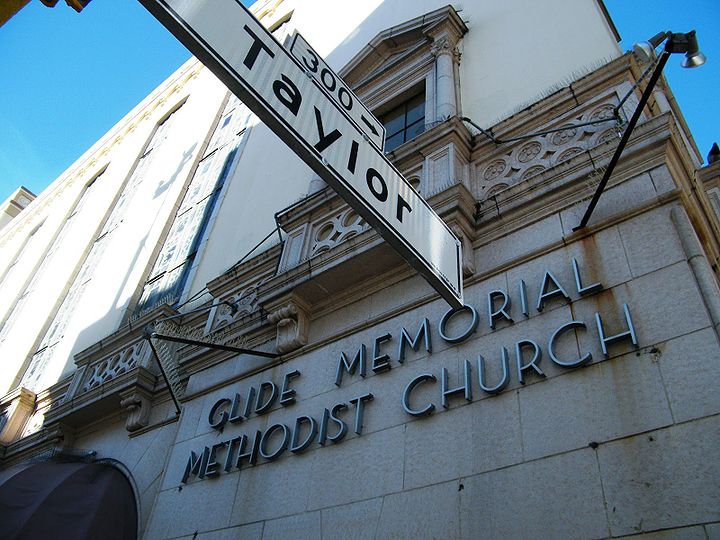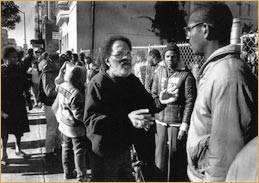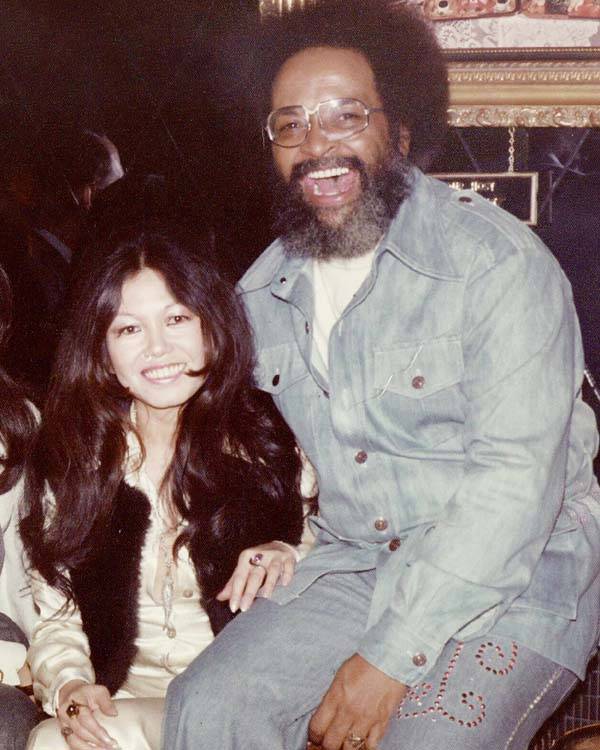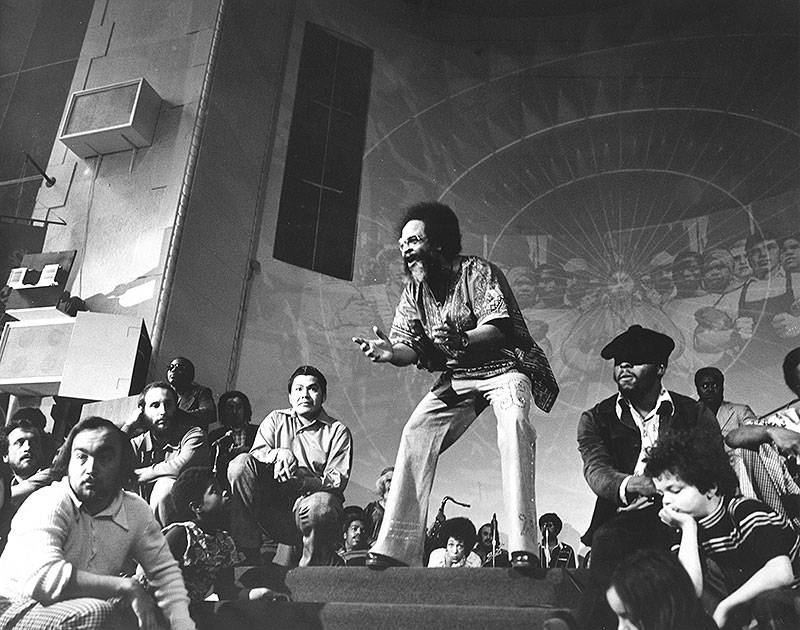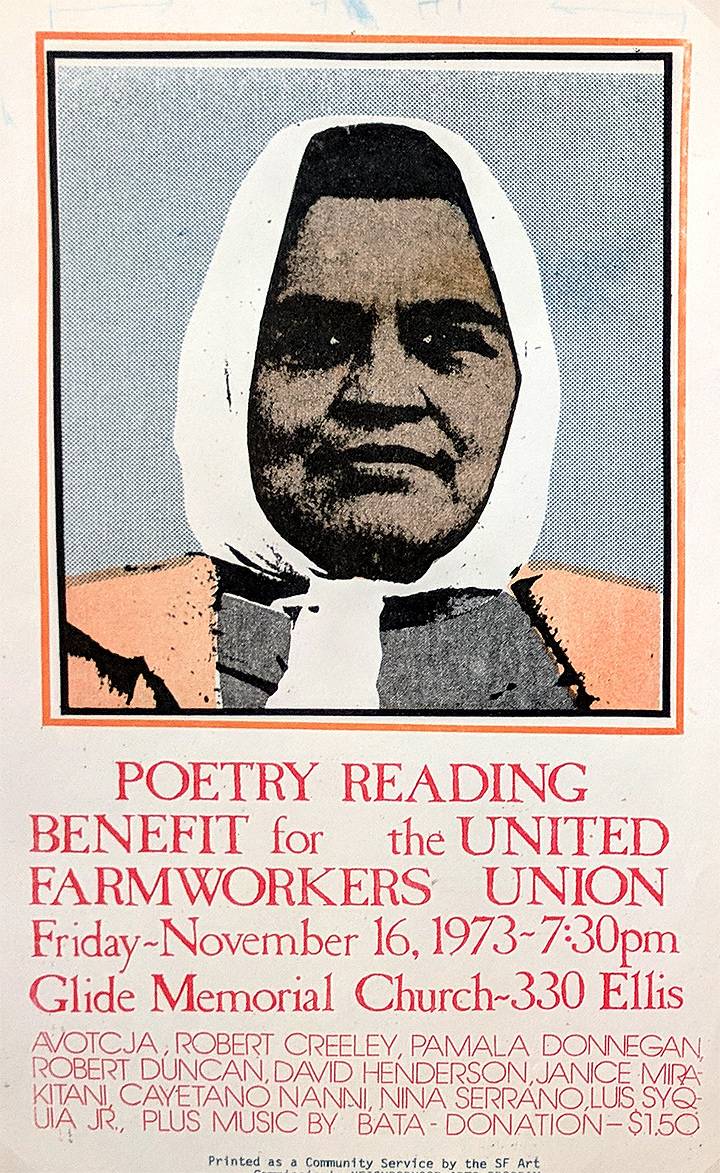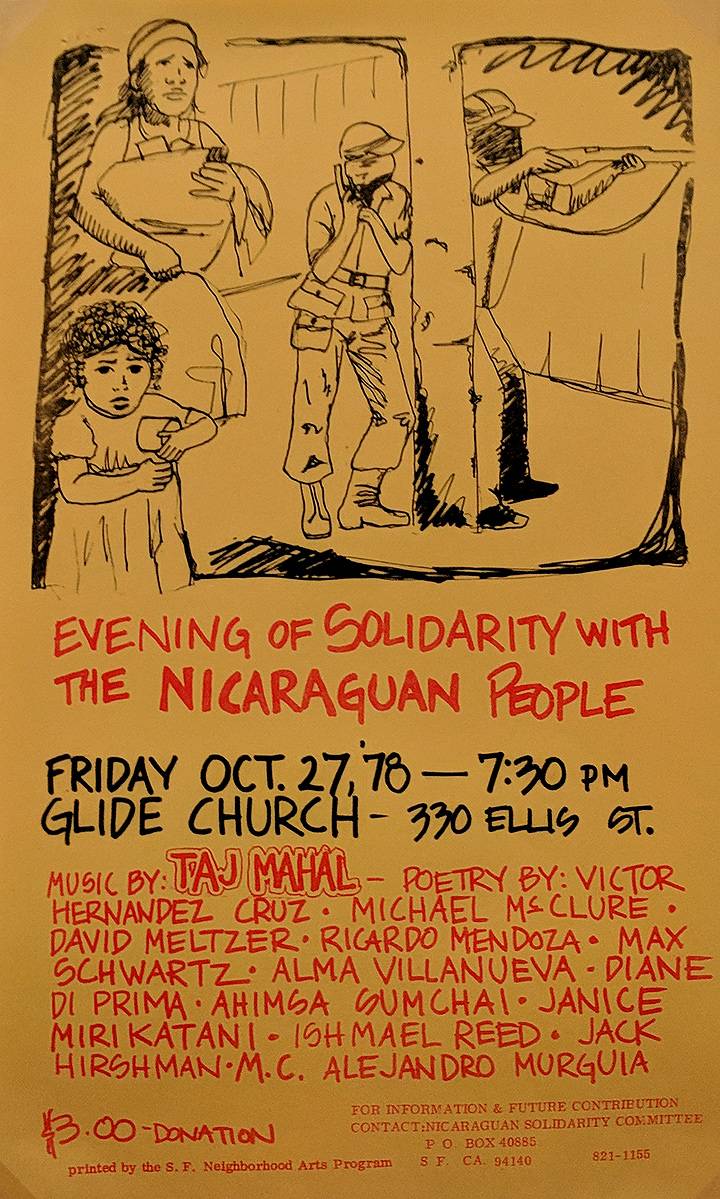Glide Memorial Methodist Church: Difference between revisions
No edit summary |
(added photo) |
||
| (5 intermediate revisions by 2 users not shown) | |||
| Line 9: | Line 9: | ||
''Photo: Chris Carlsson'' | ''Photo: Chris Carlsson'' | ||
In 1929, Methodist philanthropist Lizzie Glide founded the Glide Foundation as a memorial to her millionaire cattleman husband, H.L. Glide of Sacramento, and built the Glide Memorial United Methodist Church at the corner of Ellis and Taylor Streets. Although conservative until the 1960s, since then Glide has served as a counter-culture rallying point and has been one of the most prominently liberal churches in the United States. [[Image:Cecil williams 1967 pic 5 3.jpg|right | In 1929, Methodist philanthropist Lizzie Glide founded the Glide Foundation as a memorial to her millionaire cattleman husband, H.L. Glide of Sacramento, and built the Glide Memorial United Methodist Church at the corner of Ellis and Taylor Streets. Although conservative until the 1960s, since then Glide has served as a counter-culture rallying point and has been one of the most prominently liberal churches in the United States. This downtown Methodist church with a small congregation was transformed in 1962 when the board of its endowment fund hired the Rev. Lewis Durham. | ||
[[Image:Cecil williams 1967 pic 5 3.jpg|right]] | |||
'''Cecil Williams organizing in the Tenderloin, 1967''' | |||
''courtesy Glide Memorial Church'' | |||
Durham hired three other young clergymen, Ted McIlvenna, Cecil Williams and Don Kuhn, to develop and staff programs for the Glide Urban Center. At the time, Glide had lots of money from its endowment, but no programs. This made Glide an ideal location for new programs. | |||
[[Image:Cecil-and-Jan-early web1.jpg|left]] | |||
'''Cecil Williams and his wife Janice Mirikitani in early 1970s''' | |||
''courtesy Glide Memorial Church'' | |||
[[Image:Cecil-Williams.jpg]] | |||
'''Cecil Williams at Glide Memorial Church in an iconic photo from the early 1970s.''' | |||
''Photo: courtesy Randy Shaw'' | |||
The fabric of U.S. life was unraveling in the early 1960s, the accepted norms under severe stress from new behaviors and expectations. Progressive clergymen took to the streets to connect their ministries with marginalized persons. The Glide Urban Center in San Francisco exemplified this new urban ministry. The pastors at Glide Foundation and the church saw themselves as missionaries, who did the work important to those in the neighborhood. This included working with [[Poverty, Social Isolation, Transsexuality|gays, sex workers, “young chickens,” youth, hippies, gangs, drug addicts]] and others. Because the pastors saw themselves as missionaries or “enablers,” as Lewis Durham called it, they listened to people to determine what the church needed to address. The unexpected focus on sex and sexual identity emerged from these consultations as the Glide missionaries realized nobody was dealing with it. | |||
By the 1970s, Glide Church was a go-to venue for all sorts of political and social organizations and campaigns. Poets from the burgeoning “Third World” political movements staged benefit readings at Glide, notably a [[The New Diversity—The Early 1970s|memorial reading]] for slain Chilean president Salvador Allende and Nobel Laureate Pablo Neruda. The early women’s liberation movement was given a safe haven at Glide too, where [[Sudsofloppen: Consciousness-Raising and the Small Group as Free Space|consciousness-raising meetings]] were held in all their confusing and disorganized glory. An activist from that time remembered, “You knew where the women’s movement was: it was at Glide church at 7:30.” While the San Francisco Women’s Liberation (SFWL) meetings featured widely unfocused and extraordinarily broad discussion, the very fact of their happening attests to the shared hope that women could find a unifying terrain of thought and action—if they talked long enough. | By the 1970s, Glide Church was a go-to venue for all sorts of political and social organizations and campaigns. Poets from the burgeoning “Third World” political movements staged benefit readings at Glide, notably a [[The New Diversity—The Early 1970s|memorial reading]] for slain Chilean president Salvador Allende and Nobel Laureate Pablo Neruda. The early women’s liberation movement was given a safe haven at Glide too, where [[Sudsofloppen: Consciousness-Raising and the Small Group as Free Space|consciousness-raising meetings]] were held in all their confusing and disorganized glory. An activist from that time remembered, “You knew where the women’s movement was: it was at Glide church at 7:30.” While the San Francisco Women’s Liberation (SFWL) meetings featured widely unfocused and extraordinarily broad discussion, the very fact of their happening attests to the shared hope that women could find a unifying terrain of thought and action—if they talked long enough. | ||
[[category:Tenderloin]] [[category:Churches]] [[category:Dissent]] [[category:1960s]] [[category:1970s]] [[category:1980s]] [[category: | [[Image:UFW Glide-Church.jpg]] | ||
[[Image:Glide-Church-Nicaragua-solidarity-poetry-reading-1978.jpg]] | |||
'''Both posters produced by the [[Legacy of the Neighborhood Arts Program|Neighborhood Arts Program]], 1970s.''' | |||
[[category:Tenderloin]] [[category:Churches]] [[category:Dissent]] [[category:1960s]] [[category:1970s]] [[category:1980s]] [[category:LGBTQI]] [[category:African-American]] [[category:Literary San Francisco]] [[category:Nicaraguan]][[category:Labor]] | |||
Latest revision as of 19:37, 17 April 2021
Historical Essay
by Chris Carlsson
Glide Memorial Church at corner of Ellis and Taylor.
Photo: Chris Carlsson
In 1929, Methodist philanthropist Lizzie Glide founded the Glide Foundation as a memorial to her millionaire cattleman husband, H.L. Glide of Sacramento, and built the Glide Memorial United Methodist Church at the corner of Ellis and Taylor Streets. Although conservative until the 1960s, since then Glide has served as a counter-culture rallying point and has been one of the most prominently liberal churches in the United States. This downtown Methodist church with a small congregation was transformed in 1962 when the board of its endowment fund hired the Rev. Lewis Durham.
Cecil Williams organizing in the Tenderloin, 1967
courtesy Glide Memorial Church
Durham hired three other young clergymen, Ted McIlvenna, Cecil Williams and Don Kuhn, to develop and staff programs for the Glide Urban Center. At the time, Glide had lots of money from its endowment, but no programs. This made Glide an ideal location for new programs.
Cecil Williams and his wife Janice Mirikitani in early 1970s
courtesy Glide Memorial Church
Cecil Williams at Glide Memorial Church in an iconic photo from the early 1970s.
Photo: courtesy Randy Shaw
The fabric of U.S. life was unraveling in the early 1960s, the accepted norms under severe stress from new behaviors and expectations. Progressive clergymen took to the streets to connect their ministries with marginalized persons. The Glide Urban Center in San Francisco exemplified this new urban ministry. The pastors at Glide Foundation and the church saw themselves as missionaries, who did the work important to those in the neighborhood. This included working with gays, sex workers, “young chickens,” youth, hippies, gangs, drug addicts and others. Because the pastors saw themselves as missionaries or “enablers,” as Lewis Durham called it, they listened to people to determine what the church needed to address. The unexpected focus on sex and sexual identity emerged from these consultations as the Glide missionaries realized nobody was dealing with it.
By the 1970s, Glide Church was a go-to venue for all sorts of political and social organizations and campaigns. Poets from the burgeoning “Third World” political movements staged benefit readings at Glide, notably a memorial reading for slain Chilean president Salvador Allende and Nobel Laureate Pablo Neruda. The early women’s liberation movement was given a safe haven at Glide too, where consciousness-raising meetings were held in all their confusing and disorganized glory. An activist from that time remembered, “You knew where the women’s movement was: it was at Glide church at 7:30.” While the San Francisco Women’s Liberation (SFWL) meetings featured widely unfocused and extraordinarily broad discussion, the very fact of their happening attests to the shared hope that women could find a unifying terrain of thought and action—if they talked long enough.
Both posters produced by the Neighborhood Arts Program, 1970s.

